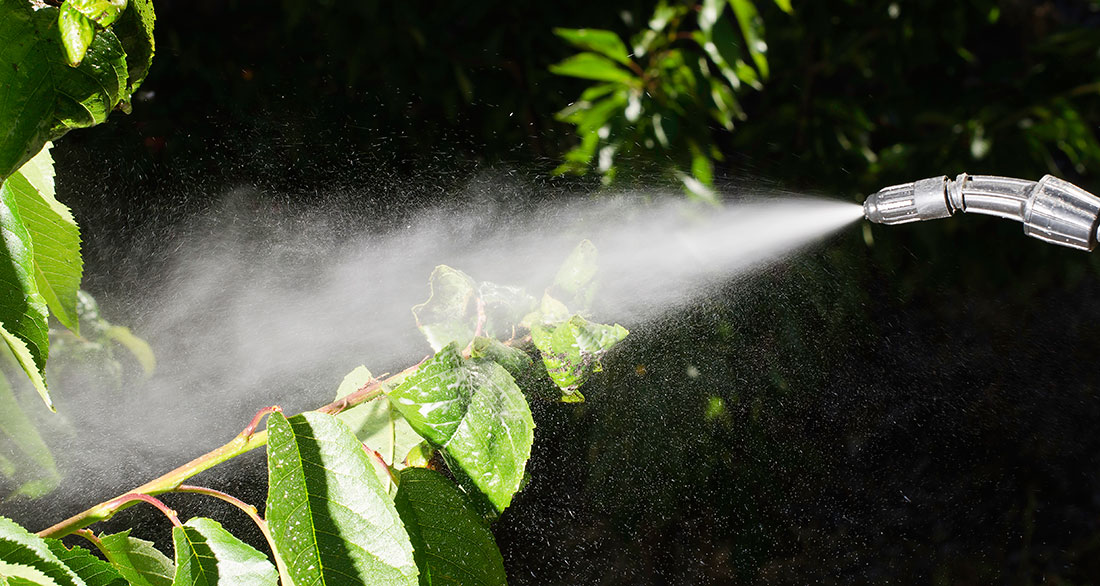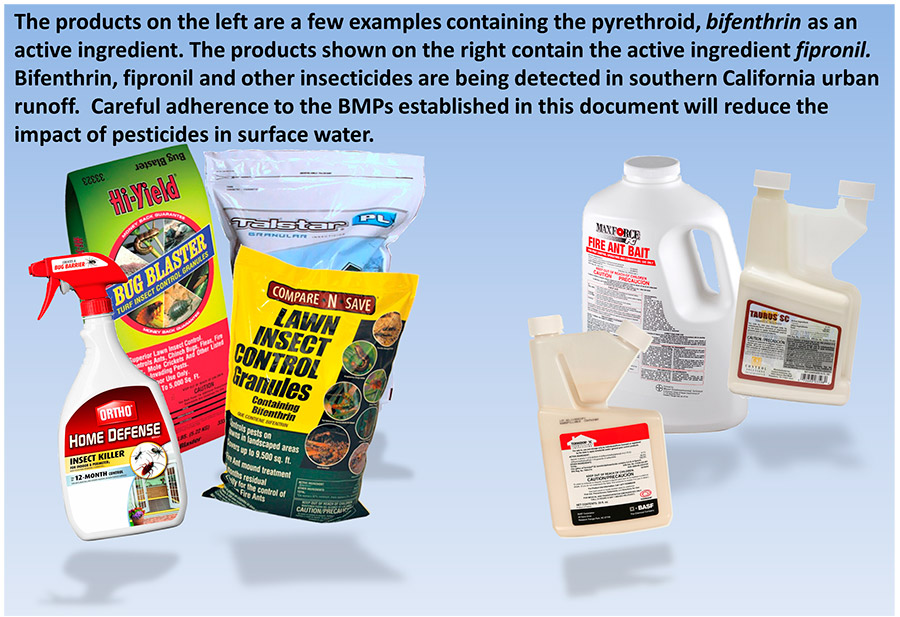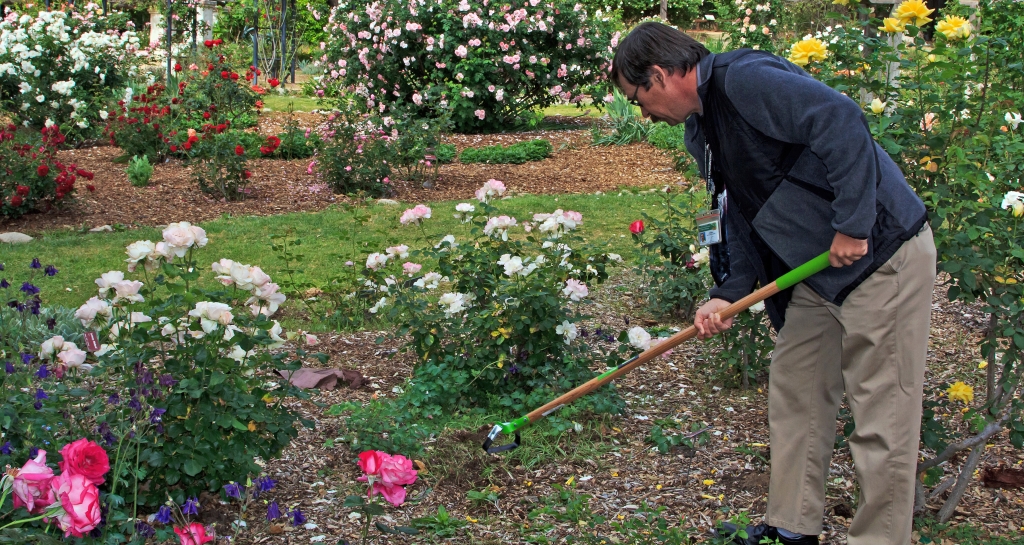SAFE AND EFFECTIVE USE OF
PESTICIDES AND FERTILIZERS
Section 8 contains a discussion of options that should always be considered before a pesticide is applied. If, after careful consideration and use of the pre-application checklist[2], it is determined that a pesticide application is necessary to achieve a tolerable damage threshold, the guidelines provided in this section should be followed to ensure a safe and effective application.
Minimizing the Impact of Pesticides/ Protection of Surface Water
Nearly every drain in landscaping flows to a gutter and ultimately a storm drain providing a direct conduit for pesticides, fertilizers, and other contaminates to enter surface water. Recent studies conducted in Southern California have detected significant levels of certain insecticides, most notably pyrethroids and fipronil. Whenever any pesticide is used outdoors at a facility, the limitations, standards of care, and best management practices outlined below should be observed to minimize the impact on the environment and prevent accidental contamination of surface water.
A red arrow (➤) signifies a State requirement (law) for the application of a pyrethroid insecticide containing one of the active ingredients listed in the sidebar on page 50 (except aerosol and bait station applications).
- Where feasible, landscaping should be designed (or redesigned) to break the direct contact between areas needing treatment and pathways to waterways
- No applications of pesticides (or fertilizers) should be made when two or more consecutive days with greater than 50% chance of rainfall are predicted by NOAA[1] or within 48 hours of a ½-inch rain event (Does not apply to aquatic pesticides or pre-emergent herbicides requiring water for activation)
- Regularly inspect irrigation for broken sprinklers and over-watering
- Drip irrigation is better than overhead watering
- Minimize or eliminate drift to hard surfaces
- An ACWM Biologist should review potential RFPs/RFBs for landscaping contractors if pest control will be part of the resulting contract (Statement of Work, proper licensing, etc.)
- Use native, drought-tolerant plants that require less water and fertilizer
- ➤ Granular products should be swept up off of impervious surfaces like sidewalks and driveways and onto the treatment area
- Avoid broad-spectrum pesticides
- Spot treatments are preferred over broadcast treatments
- Extra care should be exercised when treating slopes due to the additional potential for runoff
- Mark and/or cover storm drains or other water paths and avoid treating in those areas
- ➤ No applications shall be made:
- To any site during rain or with standing water, including puddles
- To plants, shrubs, or trees where there is standing water in the dripline or perimeter of the plants, shrubs, or trees
- To a sewer, storm drain, or curbside gutter
- To the following components of a constructed drainage system that drains to a sewer or storm drain, curbside gutter, or aquatic habitat:
- Visible drainage grate connected to a drain pipe
- Visible French drain, or a landscaped dry riverbed, swale or trench filled with gravel or rock
- To the soil surface or horizontal impervious surfaces within 25 feet of aquatic habitat located downgradient from the application
- To a preconstruction termiticide site within 10 feet of a storm drain located downgradient from the application
- ➤ Applications to the soil surface, mulch, gravel, lawn, turf, or groundcover must only be made using the methods described below:
- Spot treatments
- Pin stream treatment of one inch or less
- Perimeter band treatment of three feet wide or less from the base of a building outward
- ➤ Applications to vertical structural surfaces, such as walls, foundations, and fencing, must be made using only the methods described below:
- Spot treatments
- Crack and crevice treatment
- Pin stream treatment of one inch or less
- Perimeter band treatment up to a maximum height of two feet above the grade level
Pyrethroids are a group of synthetic insecticides which are similar in action to the botanical insecticide pyrethrin.
How do you know if the insecticide you are using is a pyrethroid? Common pyrethroid active ingredients often end in “-thrin”. Refer to the list below for more information.
Pyrethroid Insecticide Active Ingredients
- bifenthrin
- bioallethrin
- S-bioallethrin
- cyfluthrin
- beta-cyfluthrin
- gamma-cyhalothrin
- lambda-cyhalothrin
- cypermethrin
- deltamethrin
- esfenvalerate
- fenpropathrin
- tau-fluvalinate
- permethrin
- phenothrin
- prallethrin
- resmethrin
- tetramethrin
The following is a summary of the pesticide use requirements established in this Countywide IPM Program NOT including vendor licensing (See Appendix A for a more complete listing of pesticide use requirements)
For All Pesticides Used Outdoors at a County Facility
- Designation of a Certified Applicator (page 51 [Section 15])
- Pre-application checklist (page 7 [Section 8])
- Lowest risk product selected (page 53 [Section 15])
- Pre-application site review/walk-around (page 49 [Section 14])
- Verification that the employee has received training (page 49 {Section 15])
Other Pesticide Use Requirements When Applicable
- Written recommendation (page 51 [Section 15])
- Restricted Materials Permit (page 52 [Section 15])
- Notice of Intent filed (page 52 [Section 15])
- Pesticide-use reporting (page 52 [Section 15] and page 66 [Section 22])
Video on Pyrethroid Application Best Practices
Pre-Application Site Review and “Walk Around”
Before a County employee applies a pesticide, a pre-application review or “walk-around” of the site is to be conducted. The review should be performed by the Certified Applicator discussed in the Certification subsection on the following page or a responsible person designated by him or her. The review will include completion of the pre-application checklist and verification that no rain is predicted within 48 hours following the application. The walk-around will also include a check for places to avoid such as standing water, areas adjacent to drains, impervious surfaces and any slopes, swales or drainages where significant runoff is likely. The review/walk-around shall be discussed with the person conducting the application unless the same person who conducted the review/walk-around will also apply the pesticide.




